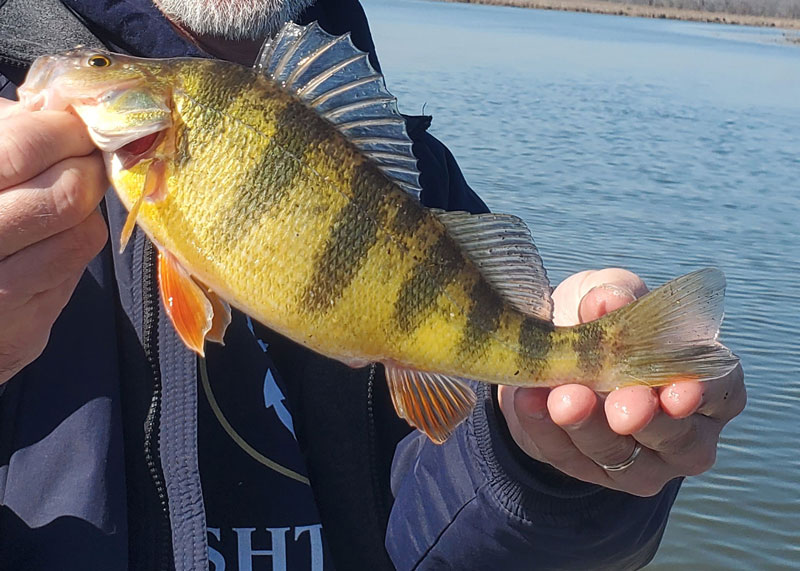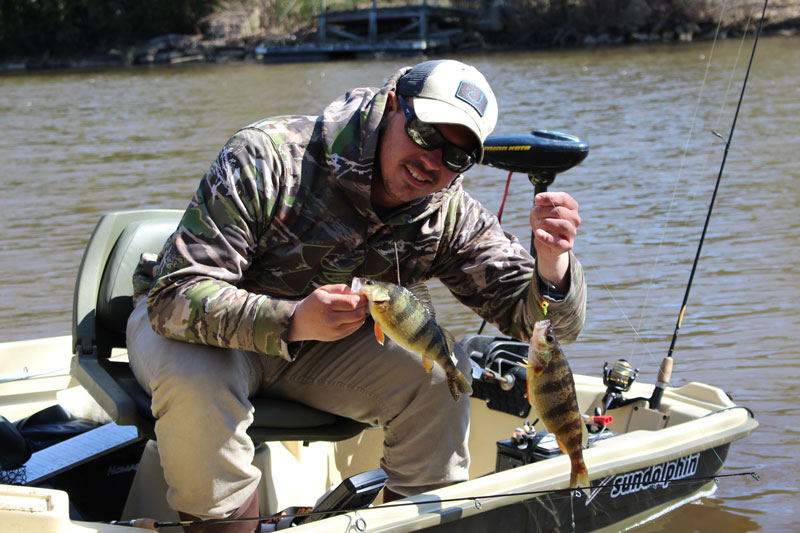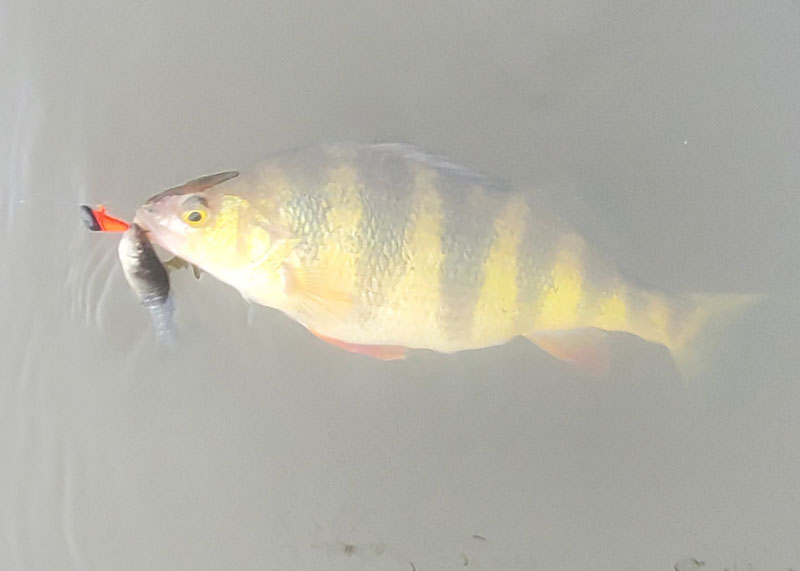Yellow perch are a widely distributed native panfish in North America, ranging from Georgia to Nova Scotia and westward all the way to southeast Alaska, and are an incredibly popular winter fishing option in much of this range. They live in both fresh and brackish waters, including all of the Chesapeake Bay tidal tributaries and many of the reservoirs in our region. The first time an angler catches a yellow perch is usually an eye-opening experience, thanks to the fish’s colorful mix of green, yellow, and fluorescent orange. Who would predict that such a gorgeous, almost tropical-looking fish would swim in our home waters?

This fish is known by many names, including ring perch, racoon perch, and yellow neds. They’re closely related to walleye and share a similar firm, very sweet meat. Yellow perch have a mixed diet and eat a wide range of invertebrates and small crustaceans, but adults eat mostly smaller finfish. They average six to nine inches but can grow to be 14” or 15”.
Record Yellow Perch
The largest yellow perch caught on hook and line was a four-pound, three-ounce fish caught in New Jersey. That mark was recorded all the way back in 1865, making it the oldest record for a freshwater fish caught in North America. As for the Chesapeake and Mid-Atlantic region, the record for yellow perch in the state of Delaware is two pounds, 11 ounces. In Maryland it’s three pounds, five ounces. The mark to beat in Pennsylvania is three pounds. And in Virginia, the largest ring perch recorded also sits at the three-pound mark.
Yellow Perch Regulations
Yellow perch regulations differ not only state by state, but also by freshwater and tidal. These can range from year-round open seasons and no bag limits to different length and bag limits. In some areas, freshwater bodies may have their own regulations specific to the one lake or reservoir. So, there are too many different rules and regs for us to cover them all here. Before you try fishing for yellow perch it’s important to check with the agency regulating the specific water body you’ll be casting in.
Yellow Perch Seasonal Availability
Yellow perch bite year-round, but where you’ll find them does change with the changing seasons. In tidal areas they spend most of the summer and fall widely scattered through tributary rivers and creeks. During this timeframe it’s often difficult to target them in specific, but you’ll catch one here and another there while fishing for other species. In the winter they school up in deep holes and channels downstream from their spring spawning grounds, and when you locate such an area, they can provide excellent winter fishing action. But it’s the early spring yellow perch run that’s generally thought of as the best time for yellow perch fishing. During the run, which historically starts in early March and can continue for up to a month, yellow perch pack into tributary headwaters in enormous numbers and often bite with abandon.

In freshwater, fishing for yellow perch tends to be more of a year-round endeavor. As a general rule of thumb freshwater perch will be found in relatively deep water in very hot and very cool weather, and during spring and fall when temperatures are milder, tend to move shallower and can often be located in and around weedbeds. Unlike some other species, however, they bite well even in very cold temperatures. So, they tend to be a wintertime favorite and in mountain lakes that freeze over, are a common target for ice fishermen.
Best Lures for Yellow Perch
Yellow perch will hit most minnow-imitating lures, with one common denominator: since these are relatively small fish, lures should be relatively small, too. Top picks include:
- Two-inch tube jigs and twister tails, fished on small jigheads.
- Shad darts
- Spinners (especially when the fish are relatively shallow)
- Blade-baits (especially when the fish are relatively deep)
- Crankbaits and twitchbaits
Best Baits for Yellow Perch
The best bait to use in freshwater is generally a shiner, though they will also eat night crawlers at times. In tidal waters there’s a bit more variety including:
- Bull (mummichog) minnow
- Grass shrimp
- Soft or peeler crab
- Bloodworms
Tip: During the winter months yellow perch in tidal waters will hit surprisingly large bull minnow. Like most species they want to expend as little energy as possible for the greatest benefit possible when it’s very cold. Never be afraid to reach for the very largest minnow in the bucket.
Bonus Tip: It’s very effective to combine a lure and bait when fishing for yellow perch. Casting shad darts tipped with a live lip-hooked bull minnow or grass shrimp is an excellent way to target them.
Double-Bonus Tip: Look out for the dorsal fin spines and gill plates on yellow perch. Both are very sharp and can easily poke or cut you. They can be safely lipped when large enough or can be grasped around the gill plates as long as you hold them closed from both sides at once.

Best Fishing Gear for Yellow Perch
Generally speaking light or ultralight gear is in order, with line in the four- to eight-pound range. Either mono or braid will work, though anglers casting lures tend to prefer braid and anglers fishing bait often like mono. Most anglers won’t add leader to mono line, but braid should be tipped with a few feet of mono or fluoro for chaff resistance.
When fishing bait (not added to a lure), using top-and-bottom rigs is the norm when fish are deeper than a few feet. If the perch are shallow suspending the bait under a bobber often works well.
If you’re ready to head out and chase those yellow perch, be sure to type “yellow perch” into the search box at the upper right on this webpage—we have plenty of in-depth information on targeting these fish in specific places at specific times. But be forewarned: if you catch a bucket full of yellow neds, take them home, and fry up some perch nuggets, there’s a very good chance that chasing these tasty panfish will become an addiction.